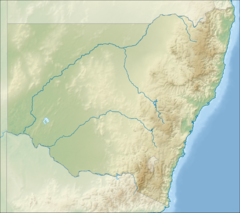Willandra National Park
| Willandra National Park | ||
|---|---|---|
|
|
||
| Location: | New South Wales , Australia | |
| Specialty: | Grasslands | |
| Next city: | Hillston | |
| Surface: | 193.86 km² | |
| Founding: | May 26, 1972 | |
The Willandra National Park is a national park in the southwest of the Australian state of New South Wales , 582 kilometers west of Sydney . It is located about 60 km west of Hillston and 170 km northwest of Griffith .
National nature and climate
Willandra National Park was established in 1972 and covers an area of approximately 19,385 hectares. It consists of 13.85 km² of flat grassland bounded to the north by Willandra Creek , which connects the Lachlan River with the Darling River .
The land around the national park is mainly used as extensive pasture for sheep and cattle. Most of the roads in this area are unpaved and become slippery or even impassable even with light rains. The climate is semi-arid with very hot summers and cold winters. The park is located on the northern edge of the Riverina plain.
history
It is believed that the land was settled by Aborigines at least 15,000 years ago. The Willandra Creek was roughly the border between the settlement areas of Wiradjuri in the south and the Wongaibon in the north.
The first European settlers came in the 1830s. In the beginning, the white colonization by sheep farmers was thin and allowed the Aborigines to continue their usual way of life. But in the 1870s and early 1880s, extensive fencing, building, and river regulation programs began as the first phase of permanent white settlement. In 1894, Willandra became the property of the London Bank of Melbourne after the Whittington Brothers ' corporate empire , who had previously owned the country, collapsed in the economic crisis of the 1890s. Under the management of Arthur and Frank Laird , Willandra became a well-known sheep breeding area in the years that followed and the owners won many awards for the high quality of their Merino herds .
In 1912 Willandra was sold to the Vickery Partnership and peaked as a ranching company in the 1920s and 1930s. Up to 90,000 sheep were sheared all at once and the land area of the farm reached 1760 km². A new manor house (which still stands today and is available as a guest house) was added in 1918. In the following years more buildings were added. The estate had a tennis court, a croquet court and orchards and has thus become - to this day - a remarkable oasis in an otherwise dry and dusty landscape.
Despite high wool prices in the 1950s, Willandra's decline began as a well-known cattle breeding business, which was exacerbated by a long drought after World War II . In 1960 the New Zealand and Australian Land Company bought Willandra and the land area of the estate decreased to 721 km². For a certain time, however, the success came back and the company employed up to 22 people.
1969 bought Dalgety Plc. the property, but failed to renew the land leases when they expired in 1971. With the expiry of the leases, the government of New South Wales withdrew the permit to use the crown land and made the area a national park in 1972. The reserve was then managed by the NSW National Parks and Wildlife Service (now part of the Department of Environment, Climate Change and Water ). In a major renovation program at the end of the 1990s, the buildings were restored to their old splendor and are now partly used as guest houses.
Flora and fauna
The park is very level with only a few elevations. For the most part, it is grassland with trees only along the waterways and around normally dry lakes and valleys. The predominant plant communities are dry eucalyptus forests and grass-rich, light forests. The light forest is dominated by eucalyptus ( Black Box , Eucalyptus largiflorens) and acacias ( River Cooba , Acacia stenophylla). Naturally occurring tree and shrub species that characterize the area include a. the pittosporum (Pittosporum phylliraeoides), Rosewood (Heterodendrum oleifolium) Hakea leucoptera and Senna eremophila.
Before European colonization began, logs , cotton bushes (Maireana aphylla) and native grasses were probably the most common forms of covering on the plains. Over 100 years of pasture and improvements in sheep breeding have changed this and the plant and animal communities no longer show the conditions as they were before European settlement. Still, Willandra is an important habitat for many native species, e.g. As the emu , the threatened Plain hikers , red and gray kangaroos , the echidna , the platypus , nine bat species and 23 reptile species, such as the Gould's Sand Goanna and the Mulga Brown Snake .
Web links
Willandra National Park . Office of Environment & Heritage. NSW National Parks and Wildlife Service
Individual evidence
- ^ Willandra National Park . Office of Environment & Heritage. NSW National Parks and Wildlife Service
- ^ Willandra National Park - Native Vegetation . Office of Environment & Heritage. NSW National Parks and Wildlife Service
- ^ Willandra National Park - Native Animals . Office of Environment & Heritage. NSW National Parks and Wildlife Service
